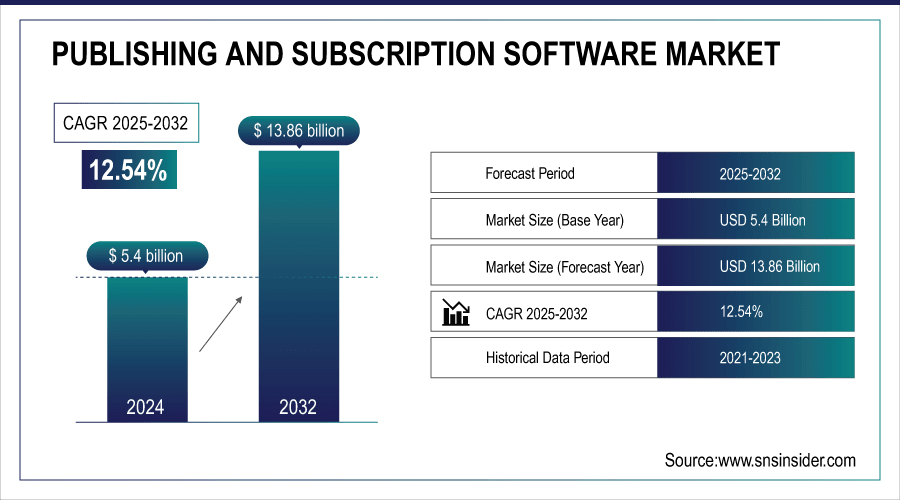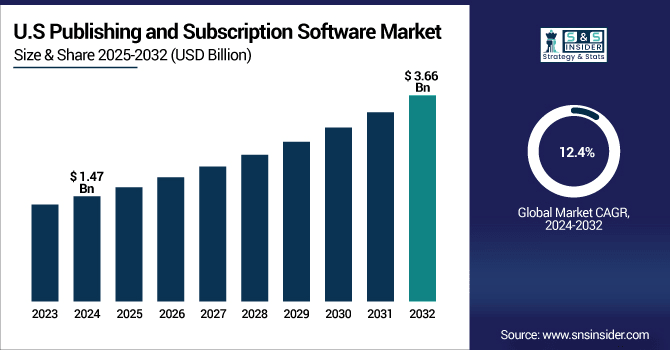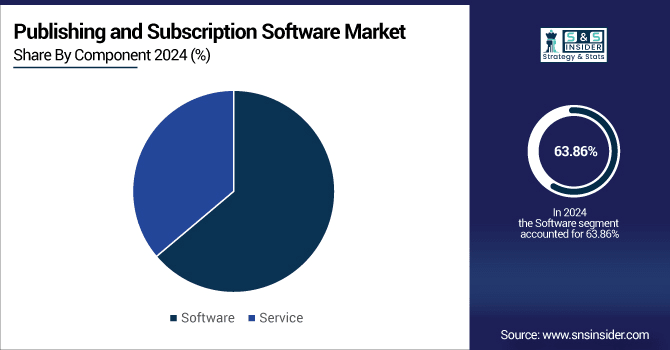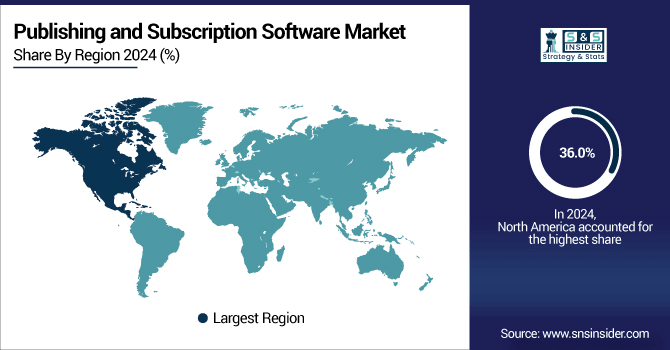Publishing and Subscription Software Market Report Scope & Overview:
The Publishing and Subscription Software Market size was valued at USD 5.4 Billion in 2024 and is projected to reach USD 13.86 Billion by 2032, growing at a CAGR of 12.54% during 2025-2032.
Publishing and subscription software market get traction owing the rise in digital information dissemination and the rise in subscription-based models that result in a regular revenue source along with user retention. Scalability driven by the cloud, personalization driven by AI, and workflows automated in the goal of efficiency all fuel adoption. With a blend of billing, CRM and integrated analytics, businesses can decrease processes and spur multi-channel publishing across web, mobile and multimedia entities. According to studies, businesses adopting subscription-based models see a recurring revenue increase of up to 30%, while cloud-based publishing software improves operational efficiency by nearly 40%.

To Get More Information On Publishing and Subscription Software Market - Request Free Sample Report
Publishing and Subscription Software Market Trends
-
Scalable, multi-channel publishing on web, mobile, and social media via cloud-based platforms
-
Artificial intelligence enabled personalization and analytics facilitates user engagement, satisfaction, and retention.
-
In developing markets, increase in e-learning, remote-work tools, and niche digital content, is pushing users to adopt.
-
Global audiences are seamlessly accessed through advanced cloud technologies and multi-language support.
-
Integration of billing, CRM, and analytics streamlines operations for tech-savvy publishers and corporates.
-
Emerging markets show strong growth potential due to rising internet and smartphone penetration.
-
AI content recommendation engine optimizes the delivery of content and monetizes the opportunity.
The U.S. Publishing and Subscription Software Market size was valued at USD 1.47 Billion in 2024 and is projected to reach USD 3.66 Billion by 2032, growing at a CAGR of 12.4% during 2025-2032. driven by high adoption of subscription-based models, advanced cloud infrastructure, and AI-powered content personalization.

Publishing and Subscription Software Market Growth Drivers:
-
Increasing Demand for Digital and Subscription-Based Business Models
The Publishing and subscription software market is growing rapidly across both the developing as well as developed regions across the globe owing to high shift from one-time purchase to subscription model. For organizations, it provides predictable streams of revenue; for customers and employees, it grants a flexible way to access digital content and services. The cloud-based platforms, along with AI-driven filtering and personalized experience, bolster user engagement, enhanced retention rates, and uniform efficiency. Continued multi-channel publishing on web, mobile and social reaches further. Along with website integration and billing, billing software even has billing, CRM, and analytics to make things easy for tech-savvy publishers and corporates helping make subscription software one of the must-haves for streamlined operations.
In January 2025, Sage introduced new features in its subscription billing solution, enhancing integration with SAP S/4HANA Cloud. These updates aim to improve billing processes for subscription-based businesses, offering more streamlined operations.
Publishing and Subscription Software Market Restraints:
-
High Implementation Cost and Integration Complexity
The market faces challenges due to significant upfront investment required for advanced platforms, training, and IT infrastructure. Small and medium enterprises, in particular, find it difficult to adopt due to budget constraints and technical complexities. Integrating subscription software with legacy systems often creates operational inefficiencies and downtime. Furthermore, concerns over data privacy, regulatory compliance, and secure billing systems act as additional barriers. These restraints slow adoption in traditional sectors, despite the clear advantages of subscription-based models.
Publishing and Subscription Software Market Opportunities:
-
Increasing E-Learning and More Niche Digital Content in Developing Markets
The market is poised for strong opportunities fuelled by proliferation of e-learning, remote-work tools, remote work and niche digital content. There are more ways of potential growth emerging, especially as the internet is not by only mature in wealthier countries anymore, and there are many countries with a quickly rising amount of people having access to the internet and smartphones. With the help of AI Analytics and recommendation engines, the providers can provide personalization experiences, which leads to better satisfaction and retention of the users. Cloud scalable, multi-language support and other advanced technologies enable to cover more markets. The activity provides opportunities for publishers to expand their local and global footprint and expand monetization avenues.
In December 2024, HubSpot enhanced its email subscription sync capabilities and introduced a serverless API, improving developer tools and expanding webhook support. These updates aim to streamline marketing automation processes
Publishing and Subscription Software Market Segment Analysis
-
By component, software led the market with ~64% share in 2024, while services are expected to be the fastest growing segment during 2025–2032, registering a CAGR of 12.71%.
-
By deployment mode, on-premises solutions dominated the market with ~55% share in 2024, whereas cloud deployment is projected to grow at the fastest pace with a CAGR of 12.70% over 2025–2032.
-
By enterprise size, small and medium enterprises (SMEs) accounted for the largest share of ~47% in 2024, while large enterprises are anticipated to witness the fastest growth at a CAGR of 12.50% during the forecast period 2025–2032.
-
By end user, the media and entertainment segment held the largest share of ~40% in 2024, whereas the education sector is expected to register the fastest growth at a CAGR of 13.60% during 2025–2032.
By Component, Software Leads Market While Service Fastest Growth
In 2024, The Software segment dominates the Publishing and Subscription Software Market, due to increase in usage of cloud-based platforms, subscription management solution, and AI driven analytics. These software tools help publishers deliver content across multi-channels seamlessly, automate workflows, and elevate subscriber engagement in return for a sustainable revenue stream. During this period, and to the Services segment is anticipated to experience the fastest growth in 2025-2032, owing to the rise in demand for integration, customization, consulting and technical support. The publication ecosystem has experienced digital transformation due to enterprises adopting managed services and training which can help minimize complexity and achieve optimal software deployment.

By Deployment Mode, On-Premises Dominate While Cloud Manufacturing Shows Rapid Growth
In 2024, the On-Premises segment dominated the Publishing and Subscription Software Market, supported by enterprises requiring full control over data security, compliance, and integration with existing IT infrastructure. Due to reliability and regulatory needs, large publishers and publishers with sensitive content often prefer on-premises models. However, the Cloud segment is expected to record the fastest growth from 2025–2032, Due to ideal scalability, low capital expense and flexibility. In addition to providing access, updates and analytics powered by AI, cloud deployment is also appealing to SMEs and global publishers as they look to digitally transform systems as well as utilize a multi-channel distribution strategy.
By Enterprise Size Industry, Small and Medium Enterprises Lead Large Enterprises Grow Fastest
In 2024, The Publishing and Subscription Software Segment market fuelled by Large Enterprises segment as they have higher budgets, established IT infrastructure, and a greater need for content distribution. Enterprise subscribers take comfort in powerful, scalable solutions featuring high-end analytics, multi-channel publishing capabilities, and integration with billing and other CRM systems to efficiently maintain large subscriber bases. At the same time, the SMEs segment will post the fastest CAGR over 2025–2032 as the segment will be driven by a growing acceptance of subscription software that is affordable and cloud-based. Use of availability of digital platforms for the delivery of niche content, automation, and hyper-personalized subscriber engagement by SMEs is driving faster market penetration and digital transformation among smaller companies.
By End User, Media and Entertainment Lead While Education Grow Fastest
In 2024, the Media and Entertainment segment dominated the Publishing and Subscription Software Market, Due to need for content distribution, subscription monetization, and personalized audience engagement across streaming platforms, digital publications, and multimedia channels. These workflows use advanced analytics, AI-driven recommendations, and cross-platform delivery to increase subscriber retention and maximize revenue for large media houses. The Education segment is expected to witness the fastest growth over 2025–2032, driven by the increasing use of e-learning, online courses, and digital libraries. As part of accelerated digital transformation in education, schools have become dependent on subscription software to manage content access, interactive, learning tools and analytics-based performance reporting.
North America Publishing and Subscription Software Market Insights
In 2024, North America dominated the Publishing and Subscription Software Market, holding approximately 36.0% share, driven by high adoption of digital content platforms, subscription-based business models, and advanced publishing software among media, corporate, and educational institutions.

Get Customized Report as Per Your Business Requirement - Enquiry Now
U.S. Dominates Publishing and Subscription Software Market with Advanced Digital Adoption
The US leads the region, due to its mature digital infrastructure, strong media industry presence, and high adoption of AI-powered analytics and multi-channel publishing solutions. Growing demand for automated subscription management, cloud integration, and enhanced personalization further supports market dominance.
Asia-pacific Publishing and Subscription Software Market Insights
In 2024, Asia-Pacific is the fastest growing region in the Publishing and Subscription Software Market, by region, delivering a CAGR of 13.54%. Due to The rapid penetration of the internet, the proliferation of mobile devices, and the growth of digital content consumption are the engines of this growth.
China and India Drive Rapid Growth in Publishing and Subscription Software Market
China and India constitute for the majority of this growth, focused on the growing uptake of e-learning, digitalization of industries, and growing interest in subscription-based publishing platforms. Cloud-enabled, scalable solutions and low-cost software deployment collectively accelerate market proliferation among media, educational, and enterprise verticals.
Europe Publishing and Subscription Software Market Insights
In 2024, Europe contributed a large share of approximately 22% in the Publishing and Subscription Software Market, supported by established media houses, digital content providers and regulatory framework around promoting digital transformation. Strong adoption of AI-enabled analytics, multi-channel content delivery, subscription management systems drive growth in the region.
Germany Leads Europe in Publishing and Subscription Software Market Growth
Germany is in pole position, benefiting from a developed IT infrastructure, a high level of digital literacy as well as increased consumption of e-learning and corporate content, thus consolidating the strength of Europe on the world market.
Latin America (LATAM) and Middle East & Africa (MEA) Publishing and Subscription Software Market Insights
The growth of the Publishing and Subscription Software Market in Latin America and the Middle East & Africa is moderate. Growing adoption of subscription-based models, increasing consumption of digital content, and rising penetration of the internet and mobile are driving demand across media, education, and enterprise verticals. However, challenges such as limited technological infrastructure, slower digital transformation, and regulatory hurdles hinder rapid adoption. Cloud-based publishing solutions, e-learning platforms, and corporate digitalization initiatives are expected to experience steady demand in spite of these barriers to entry and allow for gradual market recovery.
Direct Imaging System Market Competitive Landscape:
Adobe Systems Inc. is a global leader in creative and digital publishing solutions for a range of printing and dynamic media systems, providing industry-leading software and subscription-based services for content creation, workflow automation, and personalization. It helps enterprises across media, marketing, and digital improve efficiency, collaboration, and scalability.
-
In March 2024, Adobe introduced GenStudio, a generative AI solution designed to streamline enterprise content supply chains. The solution allows teams to generate and personalize content in an efficient manner and at scale across every digital experience.
Oracle Corporation is a leading provider of cloud and enterprise software solutions, specializing in database management, AI-driven analytics, and subscription-based platforms. The company focuses on helping enterprises optimize operations, scale efficiently, and integrate advanced technologies into business processes.
-
In August 2025, Oracle introduced Oracle AI World, evolving from its previous CloudWorld event. The event highlighted AI-driven innovations, demonstrating Oracle’s commitment to enhancing enterprise solutions with intelligent automation and subscription-based capabilities.
IBM Corporation is a global technology and consulting leader, providing enterprise software, cloud solutions, and subscription-based computing platforms. The company focuses on delivering flexible, scalable, and secure solutions for diverse industries, enabling digital transformation and operational efficiency.
-
In October 2024, IBM launched the IBM i Solution Edition with subscription term licensing for the IBM Power S1014 and S1012 models. This offering provides flexible licensing options, catering to enterprise computing and content management needs.
Publishing and Subscription Software Market Key Players:
Some of the Publishing and Subscription Software Market Companies are:
-
Adobe Systems Inc.
-
Microsoft Corporation
-
Oracle Corporation
-
SAP SE
-
IBM Corporation
-
Salesforce.com, Inc.
-
HubSpot, Inc.
-
Zoho Corporation
-
Intuit Inc.
-
Sage Group plc
-
Workday, Inc.
-
ServiceNow, Inc.
-
Atlassian Corporation Plc
-
Wolters Kluwer N.V.
-
Thomson Reuters Corporation
-
Infor, Inc.
-
Epicor Software Corporation
-
Coupa Software Incorporated
-
Xero Limited
-
Shopify Inc.
| Report Attributes | Details |
|---|---|
| Market Size in 2024 | USD 5.4 Billion |
| Market Size by 2032 | USD 13.86 Billion |
| CAGR | CAGR of 12.54% From 2025 to 2032 |
| Base Year | 2024 |
| Forecast Period | 2025-2032 |
| Historical Data | 2021-2023 |
| Report Scope & Coverage | Market Size, Segments Analysis, Competitive Landscape, Regional Analysis, DROC & SWOT Analysis, Forecast Outlook |
| Key Segments | •Component (Software, Services) •Deployment Mode (On-Premises, Cloud) •Enterprise Size (Small and Medium Enterprises, Large Enterprises) •End-User (Media and Entertainment, Education, Corporate, Government, Others) |
| Regional Analysis/Coverage | North America (US, Canada, Mexico), Europe (Germany, France, UK, Italy, Spain, Poland, Turkey, Rest of Europe), Asia Pacific (China, India, Japan, South Korea, Singapore, Australia, Taiwan, Rest of Asia Pacific), Middle East & Africa (UAE, Saudi Arabia, Qatar, South Africa, Rest of Middle East & Africa), Latin America (Brazil, Argentina, Rest of Latin America) |
| Company Profiles | Adobe Systems Inc., Microsoft Corporation, Oracle Corporation, SAP SE, IBM Corporation, Salesforce.com, Inc., HubSpot, Inc., Zoho Corporation, Intuit Inc., Sage Group plc, Workday, Inc., ServiceNow, Inc., Atlassian Corporation Plc, Wolters Kluwer N.V., Thomson Reuters Corporation, Infor, Inc., Epicor Software Corporation, Coupa Software Incorporated, Xero Limited, Shopify Inc. |

